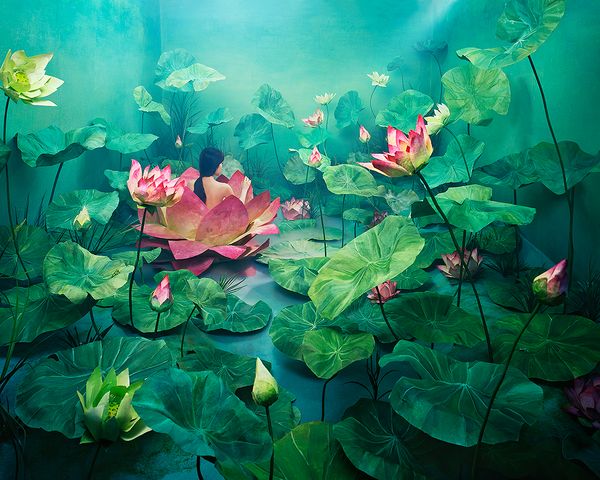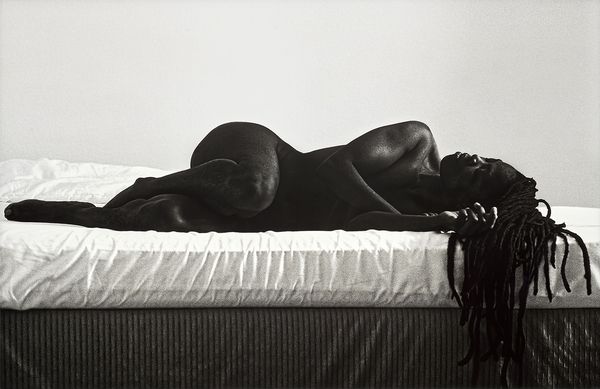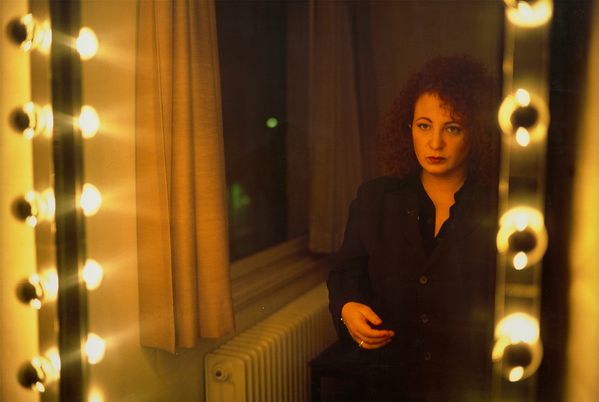Tania Franco Klein, Toaster, (Self-portrait) from Our Life in the Shadows, 2016. Photographs London.
In its ability to capture single snapshots of people, places, and events in their truest form, photography as a medium is unparalleled. What happens, then, when artists break down their own barriers and position themselves in front of their cameras? The resulting images are deeply personal, emotional, and steeped in meaning, not least because they offer their makers the opportunity to gain control of their own voice. Phillips is proud to include a selection of eye-catching self-portraits in their upcoming London Photographs sale, all of which are excitingly created by women and nonbinary artists.
Tania Franco Klein — Mexican, b.1990
For Tania Franco Klein, her self-portraiture is deeply personal. Employing retro styling and cinematic framing to stage herself as unidentified characters in undefined locations and time, the artist creates self-portraits set against domestic backdrops for her series Our Life in the Shadows.
My characters are anonymous, almost melting into places, vanishing, constantly looking for any possibility of escape. They find themselves alone, desperate, and exhausted. They are constantly teetering on the line between trying and feeling defeated.
—Tania Franco Klein
In this enticingly enigmatic series, she transforms into artistic personae to explore the psychological consequences of pursuing the so-called “American Dream.” Toaster, (self-portrait), selected for ULTIMATE this May, is a sold-out work from this series (lot 11). Franco Klein appears weighed down by life as her fatigued character rests her head on a kitchen counter, with her face — distorted and dramatically draped in light and shadow — reflected on the side of a toaster. According to the artist, her character has been worn down by media overstimulation and the societal pressure to consistently overperform.
JeeYoung Lee — South Korean, b.1983
JeeYoung Lee, Resurrection from Stage of Mind, 2011. Photographs London.
JeeYoung Lee also takes her place in front of the camera while conceptualizing, crafting, and directing each of her works. In Resurrection, offered as part of ULTIMATE this season, Lee stages herself as the protagonist. By choosing to sit inside a handcrafted, paper lotus, she plays on the flower’s sacred symbolism in East Asia to portray herself as a symbol of purity, strength, and resilience (lot 12).
The figure within a lotus blooming implies a stronger self who was just born again and is facing a new world.
—JeeYoung Lee
That she positions herself in this work is crucial, seeing as though the fantastical landscape that she constructed for this scene is a representation of her own personal dreamscape. Moreover, her physical presence in the work feeds into the performativity of the piece, which Lee cites as central to Resurrection. Her process of creating the scene and subsequently destroying it are as much a part of the work as the photographic documentation that results from the shoot, and therefore it is only logical that her body is visible in the final image.
Zanele Muholi — South African, b.1972
Zanele Muholi, Sindile II, Room 206 Fjord Hotel, Berlin from Somnyama Ngonyama, 2017. Photographs London.
Zanele Muholi has grounded their career as a self-proclaimed “visual activist” by documenting the lives of Black LGBTQIA+ individuals and communities in their native South Africa. Drawing upon their own black, nonbinary, and queer identity in their ongoing series Somnyama Ngonyama, translated from Zulu as “Hail, the Dark Lioness,” the artist becomes their own subject for the first time. In front of their camera, Muholi takes on the guise of different characters, using their own body to tell stories of the compounded suppression experienced as a result of racism and homophobia in South Africa.
We get caught up in other people’s worlds, and you never ask yourself how you became.
—Zanele Muholi
By exaggerating the darkness of their skin tone, Muholi symbolizes themself as an alternative visual history that celebrates the beauty of black skin within the lexicon of classical painting and fashion photography. Muholi recounts, “Being queer, being Black, being female-bodied is multilayered. And it is painful.” There is no more effective way of displaying and overcoming this pain for the artist than through photographic self-portraiture. With the strong and composed stances that they assume, Muholi is at last able to assert their dominance over damaging narratives against race, gender, and sexuality that have threatened the artist’s own identity. Sindile II, Room 206 Fjord Hotel, Berlin is featured in ULTIMATE and is one of four sold-out Muholi self-portraits on offer this May (lots 10, 61-63).
Tomoko Sawada — Japanese, b.1977
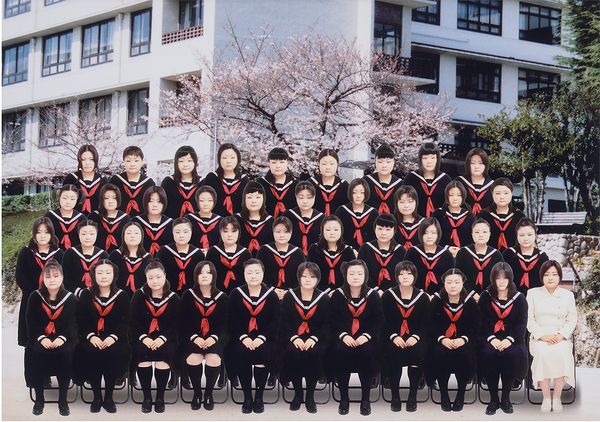
Tomoko Sawada, School Days, 2004. Photographs London.
Appearing at auction for the first time this May is Tomoko Sawada’s School Days box set, a complete set of 10 framed prints contained within a custom-made wooden display box (lot 60). This extraordinary project highlights just how personal photographic self-portraiture can be for its maker. For School Days, Sawada uses images of herself to reference the biannual class photographs that she endured throughout her six years at an all-girls junior high and high school in her hometown in Kobe, Japan. To create the 10 variations in the series (School Days A – J), the artist hired different sets of uniforms and other clothing to play 400 students and 10 teachers. The painstaking and laborious image-making process involved photographing herself 410 times — each time with subtle physical, sartorial or gestural distinctions — and the background images at her alma mater then digitally stitching them together.
Looking back to my school days, as a teenager, it was a vital thing how much I could express my own personality in a group photo among the girls who were wearing the same uniforms with similar hairstyles.
—Tomoko Sawada
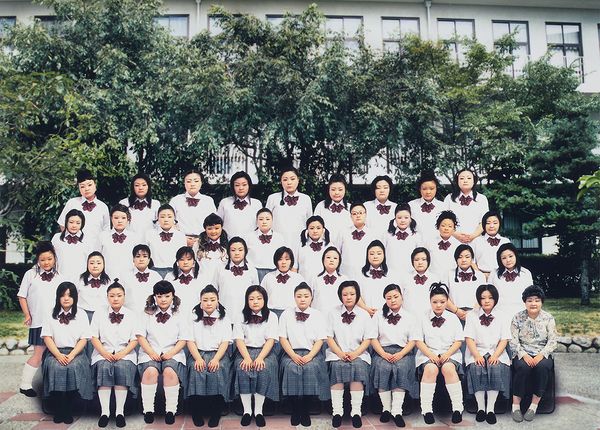
Tomoko Sawada, School Days, 2004. Photographs London.
This box set of School Days, meticulously crafted with an opening at the front to allow one work to be on view while the other nine are slotted behind it, encases all 10 iterations of the series together, displaying the myriad ways that Sawada retains her individual voice by repeatedly multiplying herself.
Nan Goldin — American, b.1953
Nan Goldin, Self Portrait in Hotel Baur au Lac, Zürich, 1998. Photographs London.
Also present in the upcoming London Photographs sale is a striking iteration of self-portraiture by Nan Goldin (lot 55). Working to depict queer communities in her native United States and beyond, Goldin offers a glimpse of herself in Self Portrait in Hotel Baur au Lac, Zürich. Unlike the other self-portraits on offer, Goldin’s photograph is not replete with characters or plot. She unapologetically captures herself in a mirror of a Swiss hotel room, depicting herself with candid spontaneity rather than with a crafted mise-en-scène.
I photograph myself in times of trouble or change in order to find the ground to stand on in the change.
—Nan Goldin
Goldin’s self-portraiture enables her to expose the intimate and vulnerable nature of her personal life. As exemplified in this work, her diaristic photographs are raw and authentic; they follow the artist through the gritty and sometimes dangerous situations in her life. Goldin once said: “I could never lose anyone if I photographed them enough.” Photographing herself therefore allows her to hold on to herself.
The London Photographs auction, including the 17th edition of ULTIMATE, is online now and will be on view in Phillips London galleries on Berkeley Square from 12 May until the live auction on 19 May, which begins at 1pm BST.
Discover More from Photographs London >
Recommended Reading
SPOTLIGHT: A Private London Collection Like No Other >

